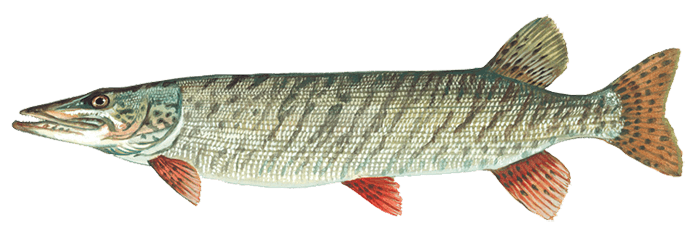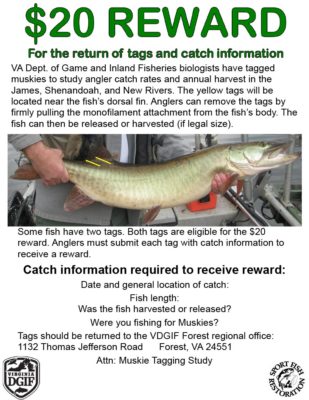Fisheries Biologist Jason Hallacher releasing a Musky.
Foggy Musky Fisheries Biologist Tyler Young with a sizeable Musky. ©Photo by Meghan Marchetti - DWR
Fact File
Scientific Name: Esox masquinongy
Classification: Fish, Order Esociformes, Family Esocidae
Size: Muskellunge "Musky" in Virginia can exceed 50 inches in length
Life Span: About 25 years
Identifying Characteristics

- Muskellunge (Esox masquinongy) are the largest member of the pike family
- Normally olive to dark gray on its back, with grayish to bluish to yellowish sides
- Sides may have faint vertical bars, spots or blotches
Distribution:
Muskellunge, more commonly referred to as Musky, have been introduced into several of Virginia’s waters due to their popularity as a sportfish among anglers. They can be targeted in portions of the James River, New River, Shenandoah River, and Upper Tennessee River basin.

Habitat
Musky prefer cool, clear lakes with abundant vegetation or long pool areas of rivers near fallen trees and other submerged structure. They prefer water temperatures ranging from 62°F – 75°F. Water temperatures up to 89°F can be stressfully tolerated, but Musky stop feeding at 84°F. During the summer Musky can be found seeking refuge where the water is cooler. When this behavior is observed it is recommended to avoid targeting these fish, as they are stressed due to warming water temperatures.
Reproduction
In Virginia, Muskies spawn in early spring at the end of March through April when waters reach 50°F – 60°F. Sexual maturity is reached at 3–5 years of age. Eggs are fertilized by 1–3 males and broadcast over aquatic vegetation, leaf mats or gravel bottoms in shallow bays and coves of lakes, or in slack pools or backwaters above or below riffles in rivers. Females release 10,000 to 250,000 eggs depending on size. Most Musky populations in reservoirs are maintained through stocking. Some rivers like the James River and the New River are maintained through natural reproduction.
Musky Management in Virginia
Musky are not believed to be native to Virginia. The first stocking of Muskellunge occurred in the New River in 1963. Since then more resources were added to the list of stocked waters or occupied by both stocked and self-sustaining populations.
Initially, hatchery musky were imported from New York, Pennsylvania, West Virginia, and Tennessee. Over the years DWR staff shifted to collecting their own brood fish, harvesting eggs, and raising Musky to various sizes to stock.
Our current stocked Muskies are considered advanced fingerlings and range in size from 8-12 inches. These fish are incredibly challenging and costly to raise. DWR staff begin the process of rearing musky in March and April.
Biologists and hatchery staff work together to collect both male and female Musky from the James River. These brood fish are shipped to the Vic Thomas hatchery. Brood fish are held for three days and checked for ripeness. Typically 150,000–200,000 eggs are harvested, fertilized, and shipped to the Buller Fish Hatchery. Buller hatchery staff monitor the eggs closely until they hatch. Brood fish are then returned to the river from where they were collected.
Once hatched, the musky fry are stocked into ponds at Buller as well as Front Royal Fish Hatchery. The fry feed on plankton, insects, and small minnows. Musky are incredibly carnivorous. If minnows run short they will cannibalize their brothers and sisters. Hatchery staff continue to monitor the ponds throughout the summer. In the fall the ponds are drained and the fingerling musky are harvested, loaded onto stocking trucks, and distributed to select resources.
Musky Research in Virginia
 Spring electrofishing and trap netting surveys are conducted on an annual or biannual basis. Trap nets are used to sample reservoirs in late March through early April; and electrofishing boats are used in January or February to sample river populations. All fish collected are measured to the nearest millimeter, weighed in grams, and released unharmed. Biologists will also periodically tag fish to measure harvest, growth, and movement.
Spring electrofishing and trap netting surveys are conducted on an annual or biannual basis. Trap nets are used to sample reservoirs in late March through early April; and electrofishing boats are used in January or February to sample river populations. All fish collected are measured to the nearest millimeter, weighed in grams, and released unharmed. Biologists will also periodically tag fish to measure harvest, growth, and movement.
For the past four years biologists have been tagging musky using a yellow floy tag on both the Upper James and South Fork and Main Stem Shenandoah Rivers. In the spring of 2019 the New River was also added to the project. The goal of this study is to help biologists determine how heavily these populations are targeted by anglers. The tags are located next to the musky’s dorsal fin. Anglers are encouraged to remove the tags by firmly pulling on the monofilament attachment and removing the entire tag from the fish’s body. The fish can then be released or harvested (if legal size). A $20 reward is awarded to anglers that mail in the tag along with the required information (see reward poster). more information regarding the muskellunge management plan can be found at this link.
Additional Information
Musky are an exciting and addicting fish to target in the waters of the Commonwealth. However, some specialized techniques and equipment are required to hunt for these trophy fish. If you are looking for a new and heart pounding fishing experience, our Musky Fishing 101 video can teach you the basics on how to get started.
Last updated: April 9, 2024
The Virginia Department of Wildlife Resources Species Profile Database serves as a repository of information for Virginia’s fish and wildlife species. The database is managed and curated by the Wildlife Information and Environmental Services (WIES) program. Species profile data, distribution information, and photography is generated by the Virginia Department of Wildlife Resources, State and Federal agencies, Collection Permittees, and other trusted partners. This product is not suitable for legal, engineering, or surveying use. The Virginia Department of Wildlife Resources does not accept responsibility for any missing data, inaccuracies, or other errors which may exist. In accordance with the terms of service for this product, you agree to this disclaimer.

